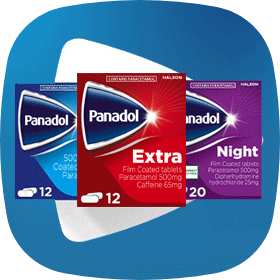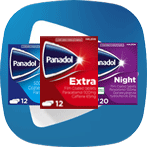A Guide to Pain Relief Options
Whether it’s due to illness, an injury, or some other condition, if you’re in pain, there’s no need to tough it out. Whatever is causing your pain, rest assured that there are pain relief options available.
Discover the many different types of pain relief that you can try – including medicinal options, as well as exercises for pain relief and some simple tips for pain management at home – with this simple guide from Panadol.

Pain Relief Medications
If you’re experiencing pain, there are several different types of common pain relief medications that can help to provide you with some temporary relief.
These medicines may be available over the counter (OTC) or by prescription from your doctor, and the medicine that’s right for you will depend on the kind of pain you’re dealing with and how severe it is.
However, before using painkillers of any kind, it’s best to consult with a doctor or pharmacist to make sure they’re appropriate for you.
Some common pain relief medicines include:
- Paracetamol – Paracetamol is a medicine you can buy at your local pharmacy or supermarket. It’s used to help ease mild to moderate pain, including headache, migraine, back pain, muscle aches, period pain, toothache, and aches and pains caused by the common cold or flu. Paracetamol-based pain relievers, like those in the Panadol range, can also help to reduce a high temperature.
- Ibuprofen– Like paracetamol, ibuprofen is also a common medicine that’s available without a prescription. It helps to relieve mild to moderate aches and pains. The key difference between the two, however, is that ibuprofen is part of a family of medicines called non-steroidal anti-inflammatory drugs (NSAIDs). Because they have anti-inflammatory properties, NSAIDs like ibuprofen are better for easing pain when swelling and inflammation are also present – for example, due to arthritis or an injury.
- Codeine– Codeine belongs to a family of medicines called opiates, which are medium-strength pain relievers. Codeine is often not used on its own, but rather regularly combined with other medications (such as paracetamol and aspirin) to help provide effective pain relief. Depending on its strength, codeine may be available to buy at a pharmacy, or it may need to be prescribed by your doctor. Since it is a higher-strength painkiller than paracetamol or ibuprofen, however, codeine is only recommended for use on a short-term basis, as there is a risk of developing dependency on codeine after long-term use.
No matter which of the above medicines you may take to help ease your pain, always use any medication exactly as directed on the product label, and read the full dosage instructions before use.
If your pain does not improve after treatment with any of these common pain relief medications, speak to your doctor. They can advise you on the appropriate next steps for easing your pain.
Exercises for Pain Relief
If muscle aches or pain are the problem, you may be surprised to learn that light exercise can often be helpful in providing effective pain relief.
While it may seem counter-intuitive to exercise when you’re experiencing body pain, in fact, certain forms of easy movement have been shown to be beneficial for sore back muscles when done regularly.

Some common types of exercise for pain relief include:
- Walking
- Light stretching
- Swimming
- Yoga
- Pilates
It’s important to speak to a healthcare professional before undertaking any of these forms of exercise if you are experiencing pain, to make sure it is safe for you to do so. They can advise you on the best exercises for your specific situation and ensure that you are not at risk of causing yourself any further pain or damage.

Pain Relief and Pain Management at Home
While there are many different types of pain relief medicines available that can go a long way to temporarily easing your pain, there are a few simple things you can do at home to help manage your pain, too.
For instance, you can:
- Apply a cold pack – If your pain is the result of an injury or another condition that’s causing muscle pain or inflammation, applying a cold pack can help give you relief. A cold compress or ice pack can help to ease pain by numbing the affected area, as well as reduce any bleeding or inflammation.
- Apply heat – A warm compress or heating pad will help to increase blood flow to the affected or painful area and reduce any joint stiffness, but it’s best not to apply heat to an injury that occurred less than 48 hours beforehand.
- Try meditation – Yes, that’s right, meditation can help ease pain. Practising simple relaxation techniques such as mindfulness and breathing exercises can reduce inflammation and ease sore muscles. This is because meditation helps to alleviate stress and allows the body to release endorphins – natural pain relievers that also help to relax your muscles and joints. Speak to your doctor about mindfulness techniques that could be right for you.
- Rest – If your pain is preventing you from moving normally (particularly if it is the result of an injury), don’t push it. Rest the affected or painful area until you feel okay to move or put weight on it again, and consult your doctor or physiotherapist before doing so. They can advise you on the best way to move forward in treating your pain.
For more tips on how to manage your specific pain at home, speak to a healthcare professional.
Learn More About Pain Relief
Panadol & pain relief











